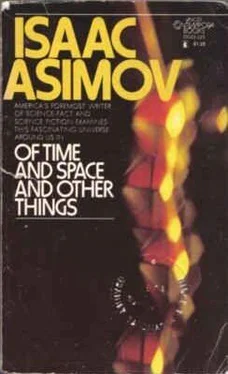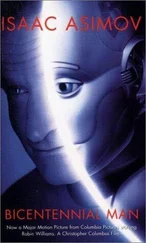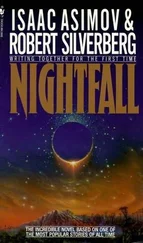Isaac Asimov - Of Time and Space and Other Things
Здесь есть возможность читать онлайн «Isaac Asimov - Of Time and Space and Other Things» весь текст электронной книги совершенно бесплатно (целиком полную версию без сокращений). В некоторых случаях можно слушать аудио, скачать через торрент в формате fb2 и присутствует краткое содержание. Год выпуска: 1972, ISBN: 1972, Издательство: Lancer Books, Жанр: Прочая научная литература, на английском языке. Описание произведения, (предисловие) а так же отзывы посетителей доступны на портале библиотеки ЛибКат.
- Название:Of Time and Space and Other Things
- Автор:
- Издательство:Lancer Books
- Жанр:
- Год:1972
- ISBN:ISBN: 0-447-33023-3
- Рейтинг книги:4 / 5. Голосов: 1
-
Избранное:Добавить в избранное
- Отзывы:
-
Ваша оценка:
- 80
- 1
- 2
- 3
- 4
- 5
Of Time and Space and Other Things: краткое содержание, описание и аннотация
Предлагаем к чтению аннотацию, описание, краткое содержание или предисловие (зависит от того, что написал сам автор книги «Of Time and Space and Other Things»). Если вы не нашли необходимую информацию о книге — напишите в комментариях, мы постараемся отыскать её.
Of Time and Space and Other Things — читать онлайн бесплатно полную книгу (весь текст) целиком
Ниже представлен текст книги, разбитый по страницам. Система сохранения места последней прочитанной страницы, позволяет с удобством читать онлайн бесплатно книгу «Of Time and Space and Other Things», без необходимости каждый раз заново искать на чём Вы остановились. Поставьте закладку, и сможете в любой момент перейти на страницу, на которой закончили чтение.
Интервал:
Закладка:
It is natural to correlate the alphabet and the number system. We are taught both about the same time in child hood, and the two ordered systems of objects naturally tend to match up. The series "ay, bee, see, dee…" comes as glibly as "one, two, three, four…" and there is no dif ficulty in substituting one for the other.
If we use undifferentiated symbols such as '" for ggseven," all the components of the symbol are identical. and all must be included without exception if. the symbol is to mean "seven" and nothing else. On the other hand, if "A,BCDEFG" stands for "seven" (count the letters and see) then, since each symbol is different, only the last need be written. You can't confuse the fact that G is the seventh letter of the alphabet and therefore stands for "seven." In this way, a one-component symbol does the work of a seven-component symbol. Furthermore, " (six) looks very much like "' (seven); whereas F (six) looks n6th ing at all like G (seven).
The Greeks used their own alphabet, of course, but let's use our own alphabet here for the complete demonstration:
A = one, B = two, C = three, D = four, E Five, F six, G = seven, H = eight, I = nine, and J = ten.
We could let the letter K go on to equal "eleven," but at that rate our alphabet will only help us up through "twenty-six." The Greeks had a better system. The Baby lonian notion of groups of ten had left its mark. If J ten, then J equals not only ten objects but also one group of tens. Why not, then, continue the next letters as numbering groups of tens?
In other words J = ten, K twenty, L = thirty, M = forty, N = fifty, 0 = sixty, P seventy, Q = eighty, R = ninety. Then we can go on to number groups of hundreds:
S one hundred, T = two hundred, U = three hundred,
V four hundred, W = five hundred, X = six hundred,
Y seven hundred, Z = eight hundred. It would be con venient to go on to nine hundred, but we have run out of letters. However, in old-fashioned alphabets the amper sand ( amp;) was sometimes placed at the end of the alphabet, so we can say that amp; = nine hundred.
The first nine letters, in other words, represent the units from one to nine, the second nine letters represent the tens groups from one to nine, the third nine letters represent the hundreds groups from one to nine. (The Greek alpha bet, in classic times, had only twenty-four letters where twenty-seven are needed, so the Greeks made use of three archaic letters to fill out the list.)
This system possesses its advantages and disadvantages over the Babylonian system. One advantage is that any number under a thousand can be given in three symbols.
For instance, by the system I have just set up with our alphabet, six hundred seventy-five is XPE, while eight hun dred sixteen is ZJF.
One disadvantage of the Greek system, however, is that the significance of twenty-seven different symbols must be carefully memorized for the use of numbers to a thousand, whereas in the Babylonian system only three different sym bols must be memorized.
Furthermore, the Greek system cofnes to a natural end when the letters of the alphabet are used up. Nine hun dred ninety-nine ( amp;RI) is the largest number that can be written without introducing special markings to indicate that a particular symbol indicates groups of thousands, tens of thousands, and so on. I will get back to this later.
A rather subtle disadvantage of the Greek system was that the same symbols were used for numbers and words so that the mind could be easily distracted. For instance, the Jews of Graeco-Roman times adopted the Greek sys tem of representing numbers but, of course, used the He brew alphabet-and promptly ran into a difficulty. The number "fifteen" would naturally be written as "ten-five."
In the Hebrew alphabet, however, "ten-five" represents a short version of the ineffable name of the Lord, and the Jews, uneasy at the sacrilege, allowed "fifteen" to be repre sented as "nine-six" instead.
Worse yet, words in the Greek-Hebrew system look like numbers. For instance, to use our own alphabet, WRA is "five hundred ninety-one." In the alphabet system it doesn't usually matter in which order we place the symbols though, as we shall see, this came to be untrue for the Roman numerals, which are alphabetic, and WAR also means "five hundred ninety-one." (After all, we can say "five hundred one-and-ninty" if we wish.) Consequently, it is easy to be lieve that there is something warlike, martial, and of omi nous import in the number "five hundred ninety-one."
The Jews, poring over every syllable of the Bible in their effort to copy the word of the Lord with the exactness that reverence required, saw numbers in all the words, and in New Testament times a whole system of mysticism rose over the numerical interrelationships within the Bible. This was the nearest the Jews came to mathematics, and they called this numbering of words gematria, which is a distor-' tion of the Greek geometria. We now call it "numerology."
Some poor souls, even today, assign numbers to the dif ferent letters and decide which names are lucky and which unlucky, and which boy should marry which girl and so on. It is on'e of the more laughable pseudo-sciences.
In one case, a piece of gematria had repercussions in later history. This bit of gematria is to be found in "The Revelation of St. John the Divine," the last book of the New Testament-a book which is written in a mystical fashion that defies literal understanding. The reason for the lack of clarity seems quite clear to me. The author of Revelation was denouncing the Roman government and was laying himself open to a charge of treason and to sub sequent crucifixion if he made his words too clear. Conse 153 quently, he made an effort to write in such a way as to be perfectly clear to his "in-group" audience, while remaining completely meaningless to the Roman authorities.
In the thirteenth chapter he speaks of beasts of diaboli cal powers, and in the eighteenth verse he says, "Here is wisdom. Let him that hath understandino, count the number of the beast: for it is the number of a man; and his number is Six hundred three-score and six."
Clearly, this is designed not to give the pseudo-science of gematria holy sanction, but merely to serve as a guide to the actual person meant by the obscure imagery of the chapter. Revelation, as nearly as is known, was written only a few decades after the first great persecution of Chris tians under Nero. If Nero's name ("Neron Caesar") is written in Hebrew characters the sum of the numbers rep resented by the individual letters does indeed come out to be six hundred sixty-six, "the number of the beast."
Of course, other interpretations are possible. In fact, if Revelation is taken as having significance for all time as well as for the particular time in which it was written, it may also refer to some anti-Christ of the future. For this reason, generation after generation, people have made at tempts to show that, by the appropriate ju-glings of the spelling of a name in an appropriate language, and by the appropriate assignment of numbers to letters, some par ticular personal enemy could be made to possess the num ber of the beast.
If the Christians could apply it to Nero, the Jews them selves might easily have applied it in the next century to Hadrian, if they had wished. Five centuries later it could be (and was) applied to Mohammed. At the time of the Ref ormation, Catholics calculated Martin Luther's name and found it to be the number of the beast, and Protestants re turned the compliment by making the same discovery in the case of several popes.
Later still, when religious rivalries were replaced by na tionalistic ones, Napoleon Bonaparte and William 11 were appropriately worked out. What's more, a few minutes' work with my own system of alphabet-numbers shows me that "Herr Adolif Hitler" has the number of the beast. (I need that extra "I" to make it work.)
Читать дальшеИнтервал:
Закладка:
Похожие книги на «Of Time and Space and Other Things»
Представляем Вашему вниманию похожие книги на «Of Time and Space and Other Things» списком для выбора. Мы отобрали схожую по названию и смыслу литературу в надежде предоставить читателям больше вариантов отыскать новые, интересные, ещё непрочитанные произведения.
Обсуждение, отзывы о книге «Of Time and Space and Other Things» и просто собственные мнения читателей. Оставьте ваши комментарии, напишите, что Вы думаете о произведении, его смысле или главных героях. Укажите что конкретно понравилось, а что нет, и почему Вы так считаете.












